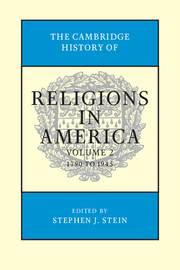Book contents
- Frontmatter
- Contents
- Contributors
- Editor's Introduction
- SECTION I RELIGION IN NORTH AMERICA
- SECTION II RELIGIONS IN THE NEW NATION, 1790–1865
- SECTION III CHANGING RELIGIOUS REALITIES
- SECTION IV RELIGIOUS RESPONSES TO MODERN LIFE AND THOUGHT
- 21 Religion and Immigration, 1865–1945
- 22 Religion and the Modern City, 1865–1945
- 23 Religious Responses to Industrialization, 1865–1945
- 24 Religious Responses to Modern Science, 1865–1945
- 25 Religious Responses to Philosophy in America, 1865–1945
- 26 Fundamentalism
- 27 Religiously Informed Social Reform and Reaction in the Era of the Great Depression
- 28 Nativism from the New Republic to the Cold War
- 29 Between God and Caesar: World War I and America's Religious Communities
- 30 World War II and America's Religious Communities
- SECTION V COMPARATIVE ESSAYS
- SECTION VI RELIGION AND DIVERSE AREAS
- Index
- References
26 - Fundamentalism
from SECTION IV - RELIGIOUS RESPONSES TO MODERN LIFE AND THOUGHT
Published online by Cambridge University Press: 28 July 2012
- Frontmatter
- Contents
- Contributors
- Editor's Introduction
- SECTION I RELIGION IN NORTH AMERICA
- SECTION II RELIGIONS IN THE NEW NATION, 1790–1865
- SECTION III CHANGING RELIGIOUS REALITIES
- SECTION IV RELIGIOUS RESPONSES TO MODERN LIFE AND THOUGHT
- 21 Religion and Immigration, 1865–1945
- 22 Religion and the Modern City, 1865–1945
- 23 Religious Responses to Industrialization, 1865–1945
- 24 Religious Responses to Modern Science, 1865–1945
- 25 Religious Responses to Philosophy in America, 1865–1945
- 26 Fundamentalism
- 27 Religiously Informed Social Reform and Reaction in the Era of the Great Depression
- 28 Nativism from the New Republic to the Cold War
- 29 Between God and Caesar: World War I and America's Religious Communities
- 30 World War II and America's Religious Communities
- SECTION V COMPARATIVE ESSAYS
- SECTION VI RELIGION AND DIVERSE AREAS
- Index
- References
Summary
The rise of Protestant Fundamentalism, a movement that began in the post–Civil War decades and reached the peak of its influence in the mid-twentieth century, is a frequently misunderstood but important episode in American religious history. At first glance, Fundamentalism's combative and angular style – it has often been defined as “militant antimodernism” – seems out of place within the general narrative of American Protestantism that has emphasized the spread of pluralism and tolerance. Not surprisingly, the historians and social theorists who began to write about Fundamentalism in the 1930s and 1940s interpreted it as a temporary aberration, at best a curious cultural cul-de-sac proving the general rule of declining religious polarization in the face of rising secularism.
Events of the late twentieth century forever changed that perception. The growing political power of the religious Right in the United States, the rise of militant Islam, and the explosion of Pentecostal sects around the world forced scholars to abandon the very notion of religious decline and, to a degree, the narrative of tolerance. After the 1980s, the new agenda was to explain the durability of traditional religion in the modern world and to explain the success of antimodern faith in a presumably secular age. Many observers began to include American Protestant Fundamentalism within this larger social reality, as one of many reactionary religious movements standing in opposition to the social and political encroachments of modernity.
- Type
- Chapter
- Information
- The Cambridge History of Religions in America , pp. 569 - 594Publisher: Cambridge University PressPrint publication year: 2000

